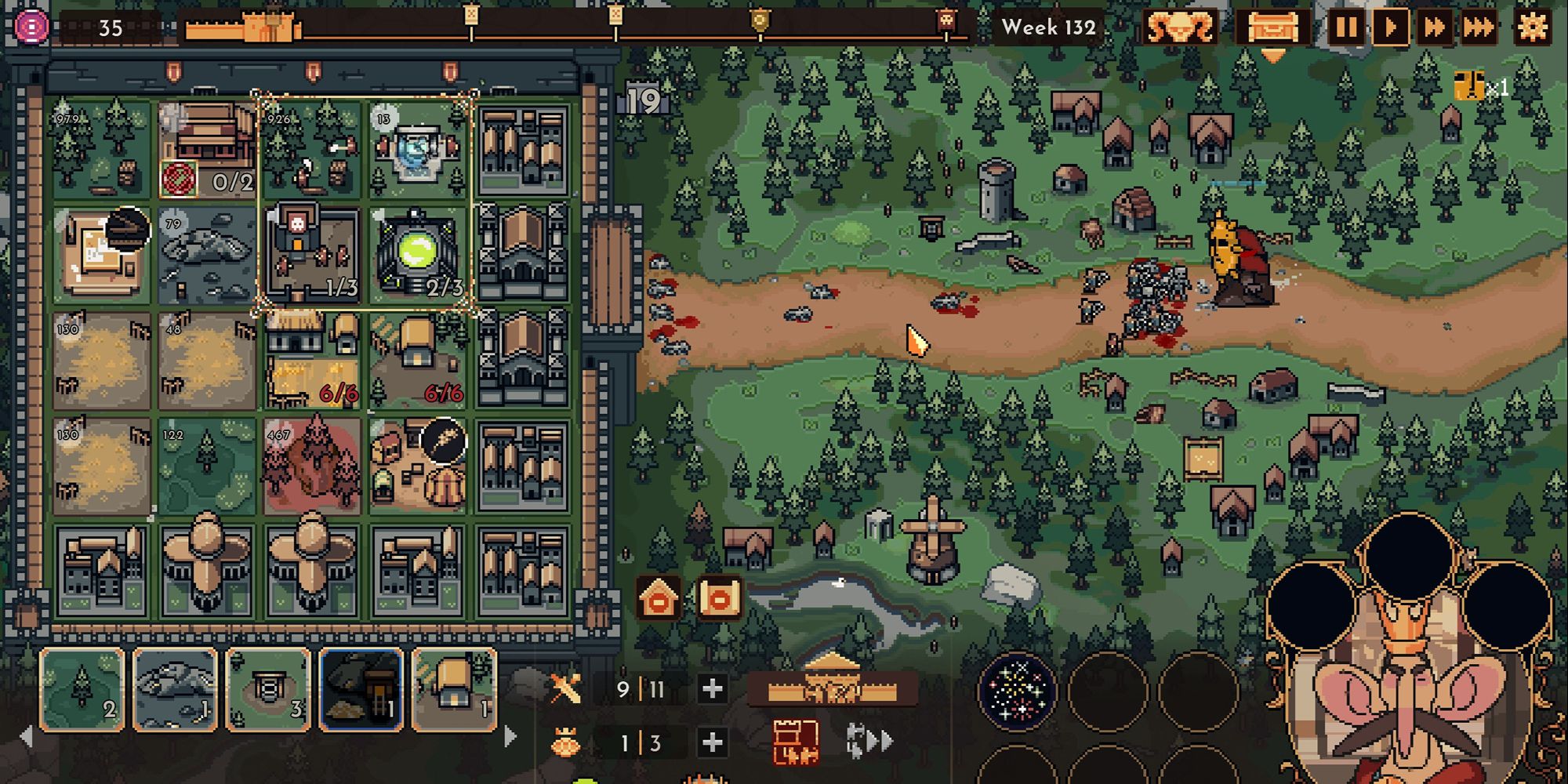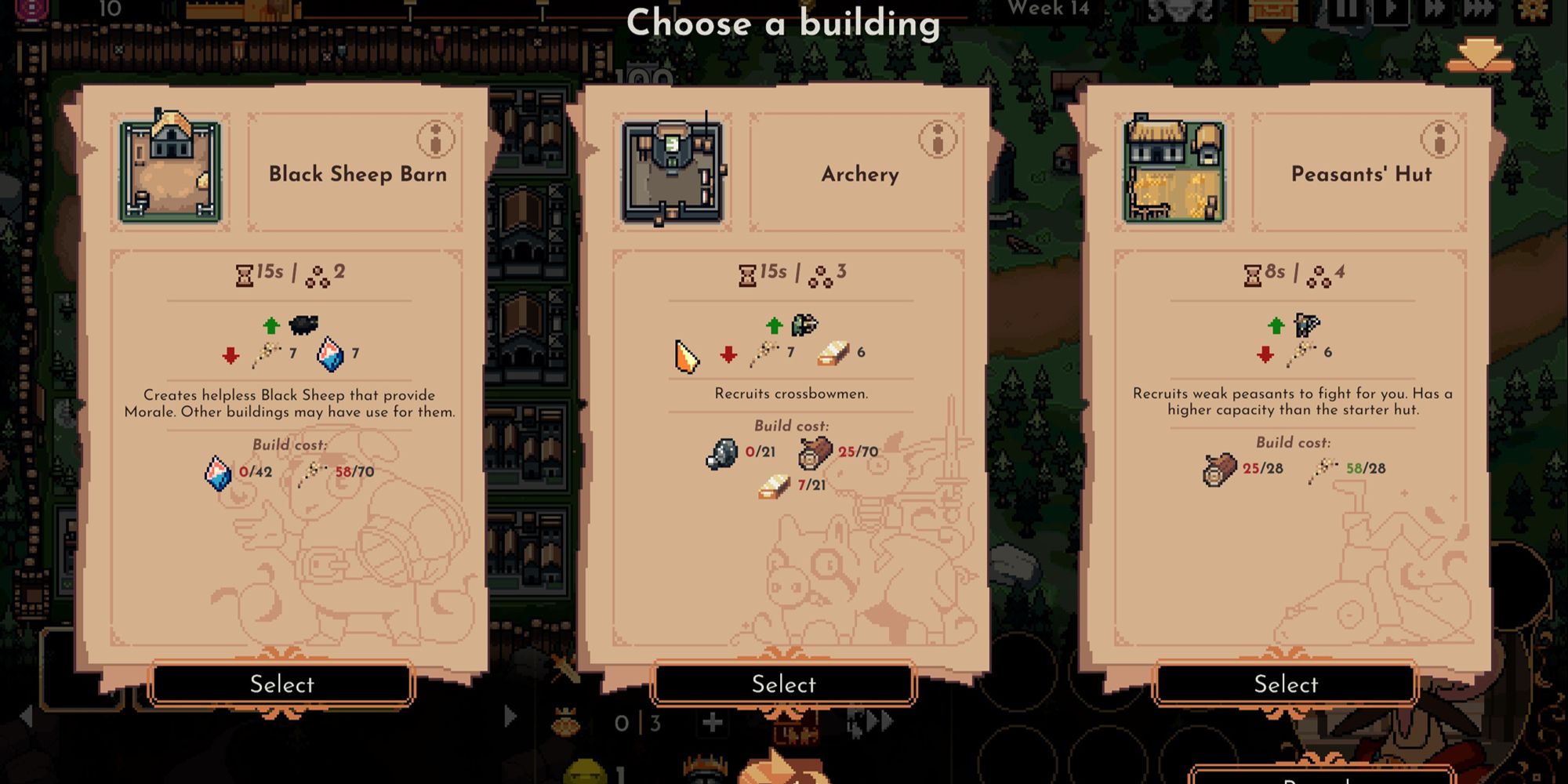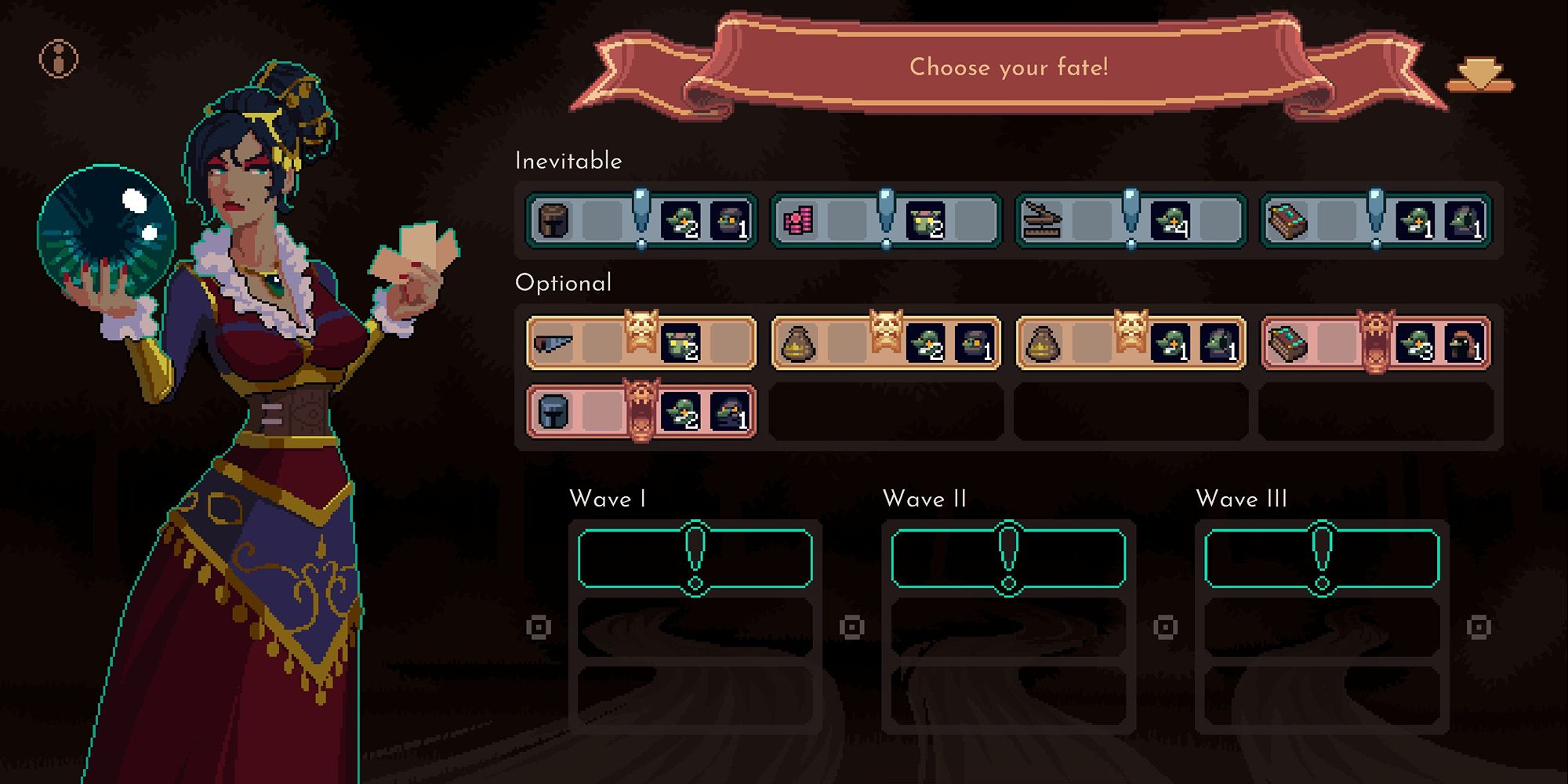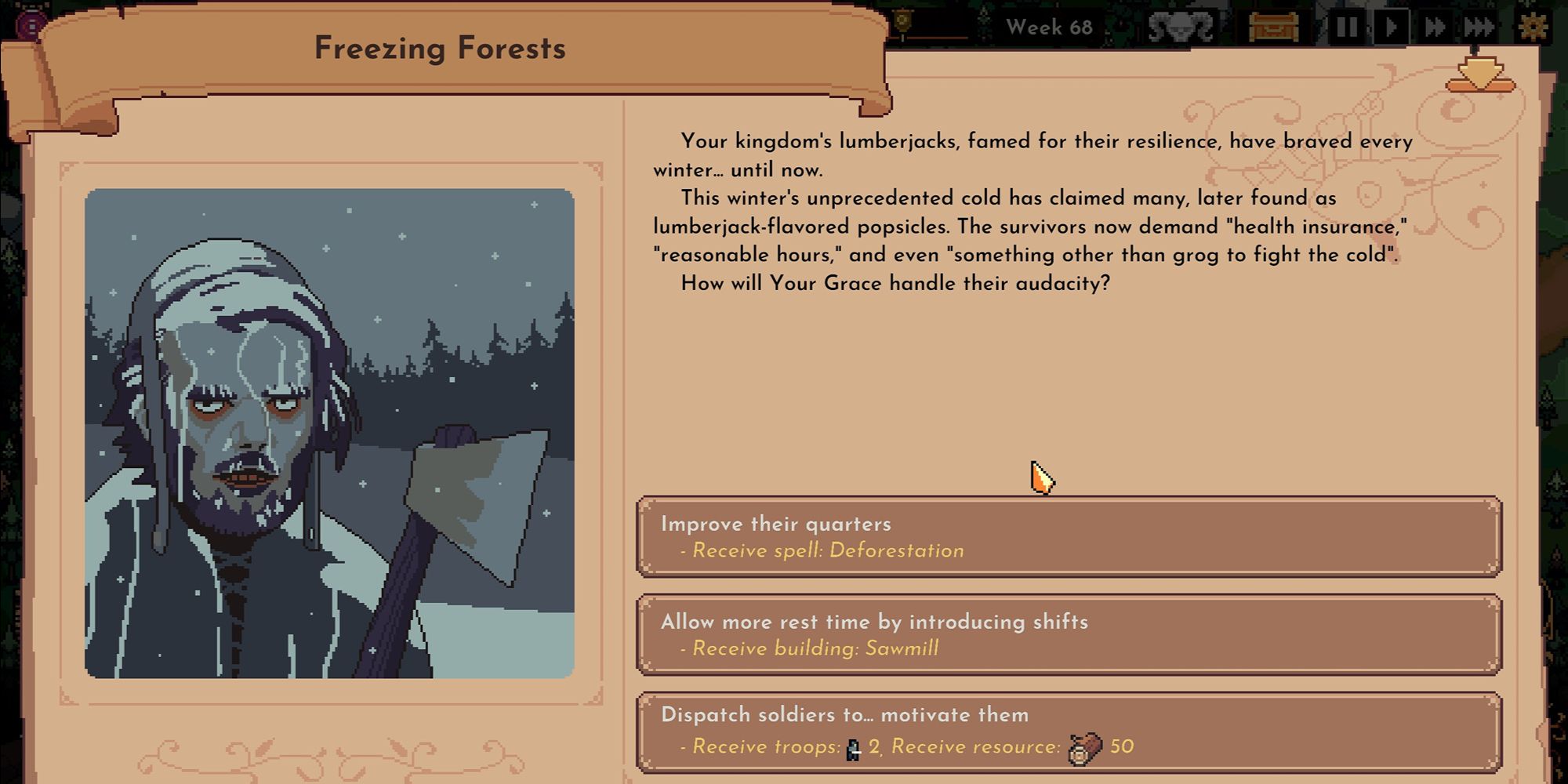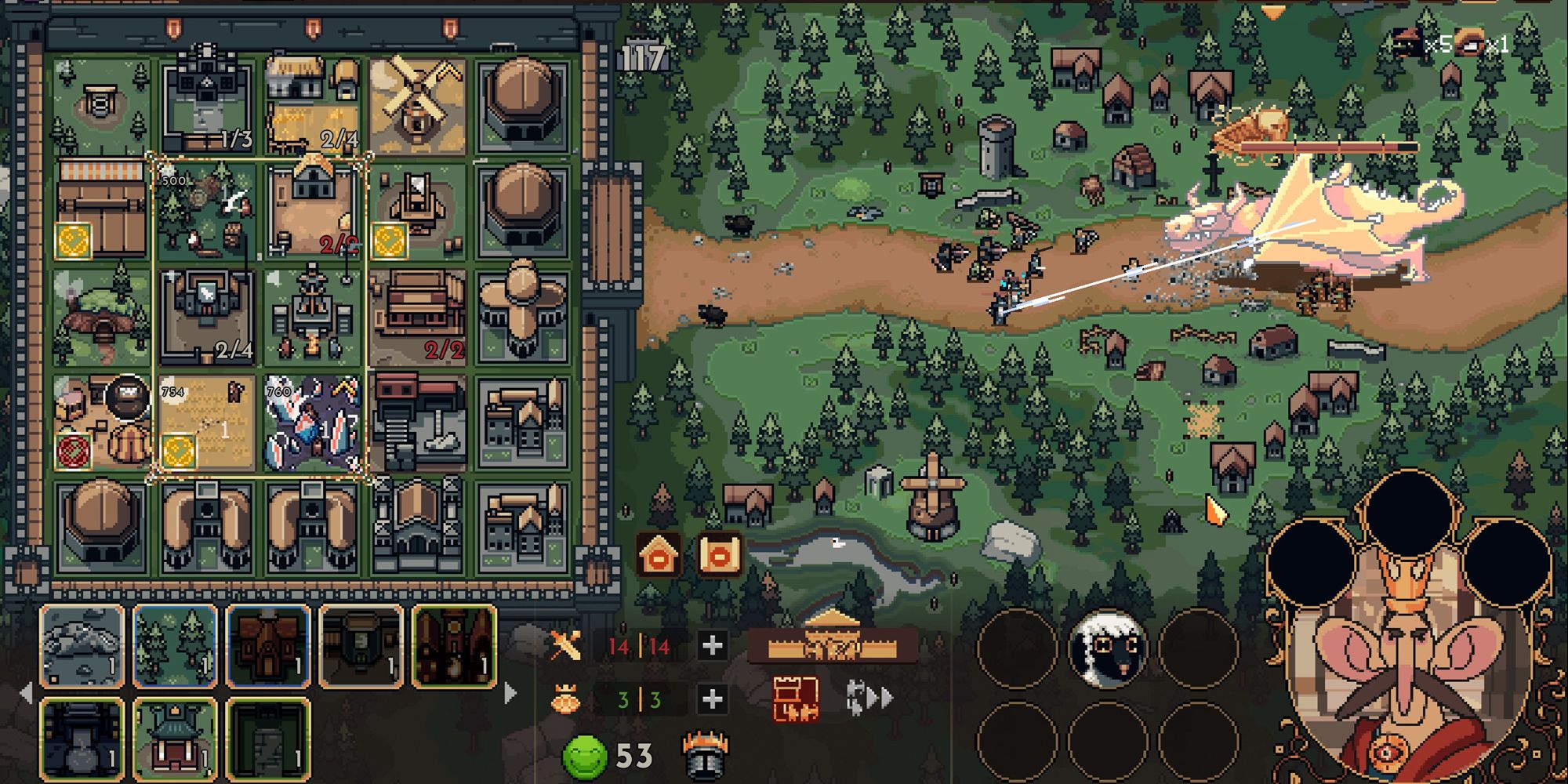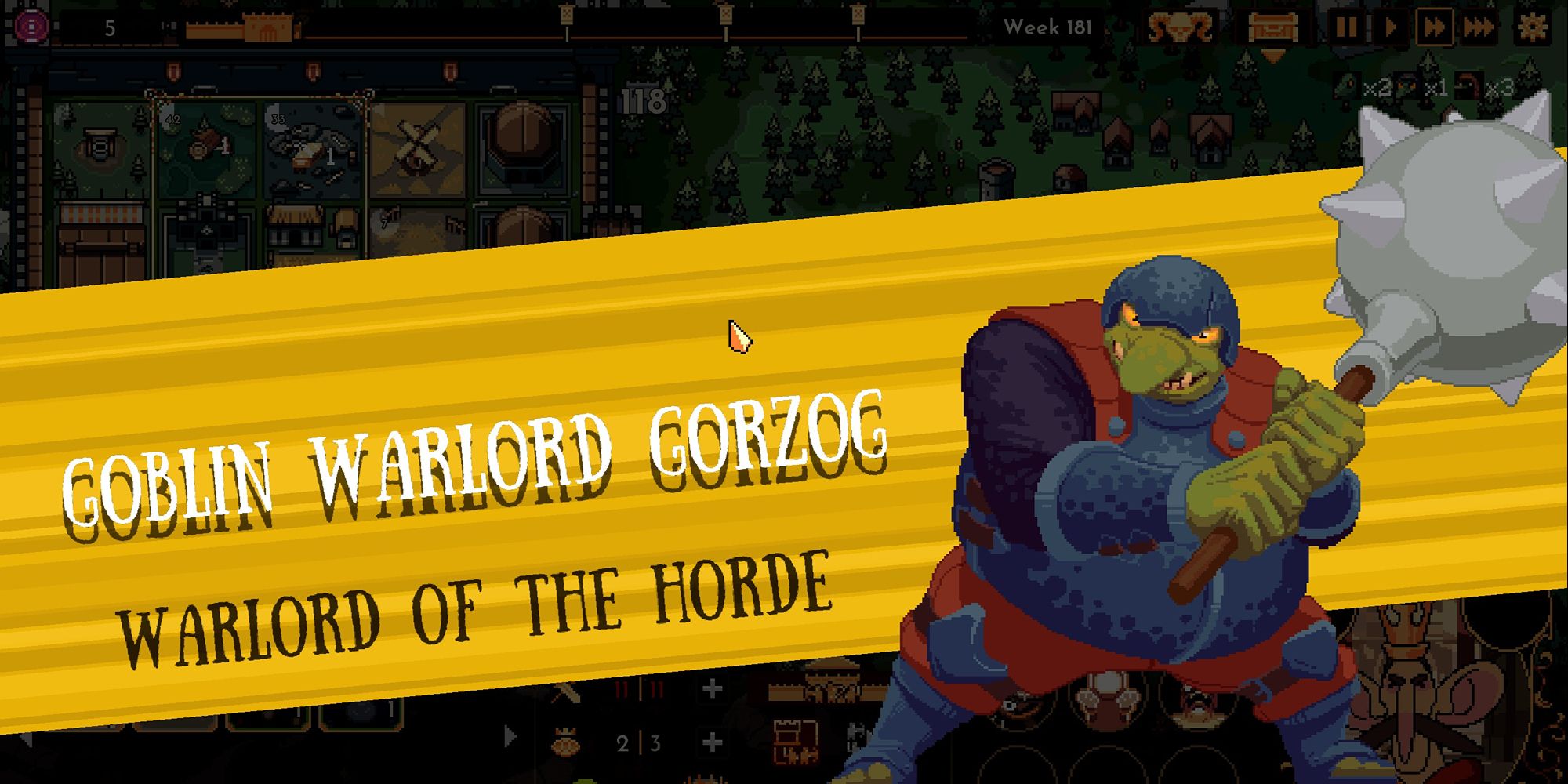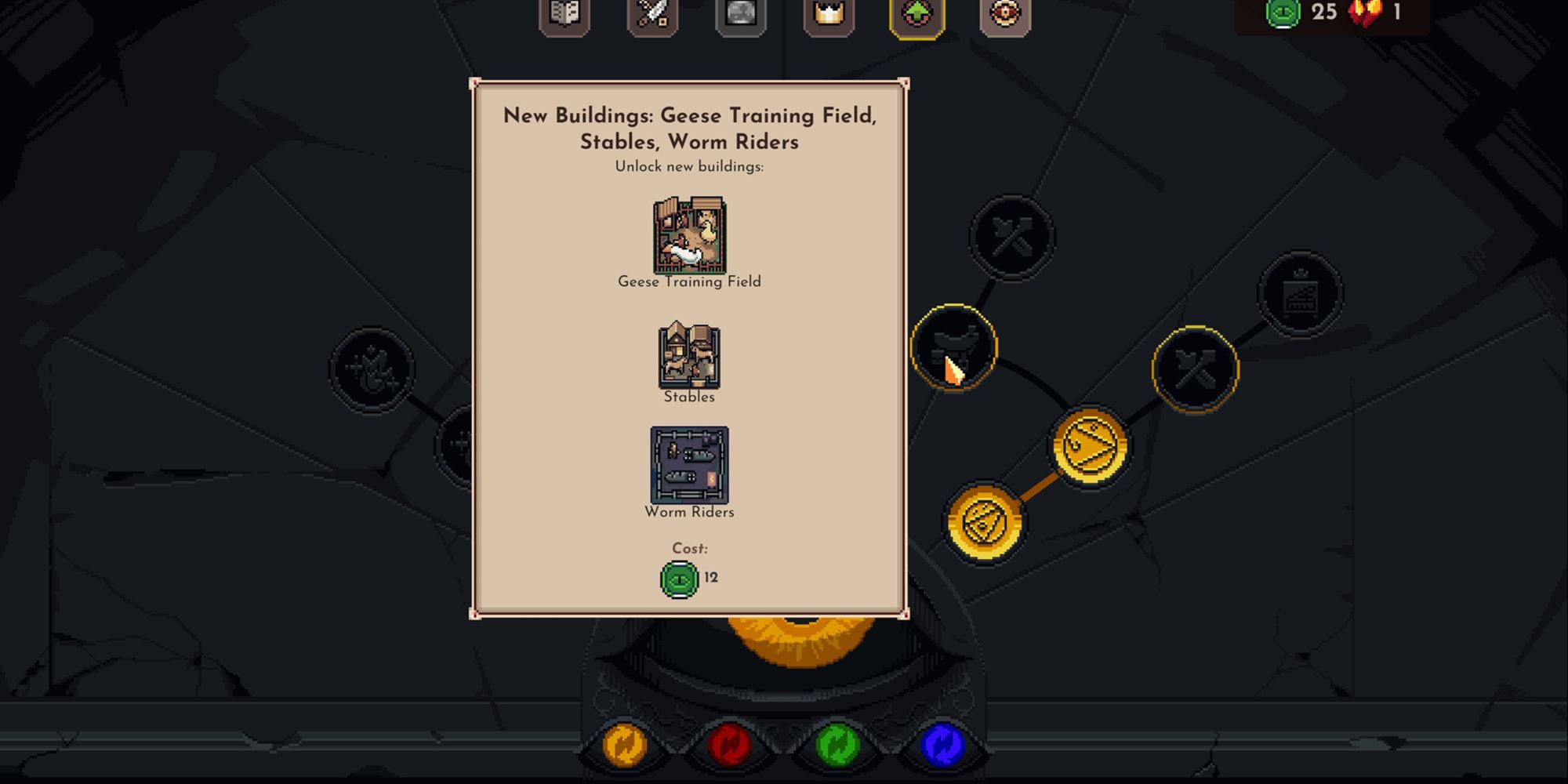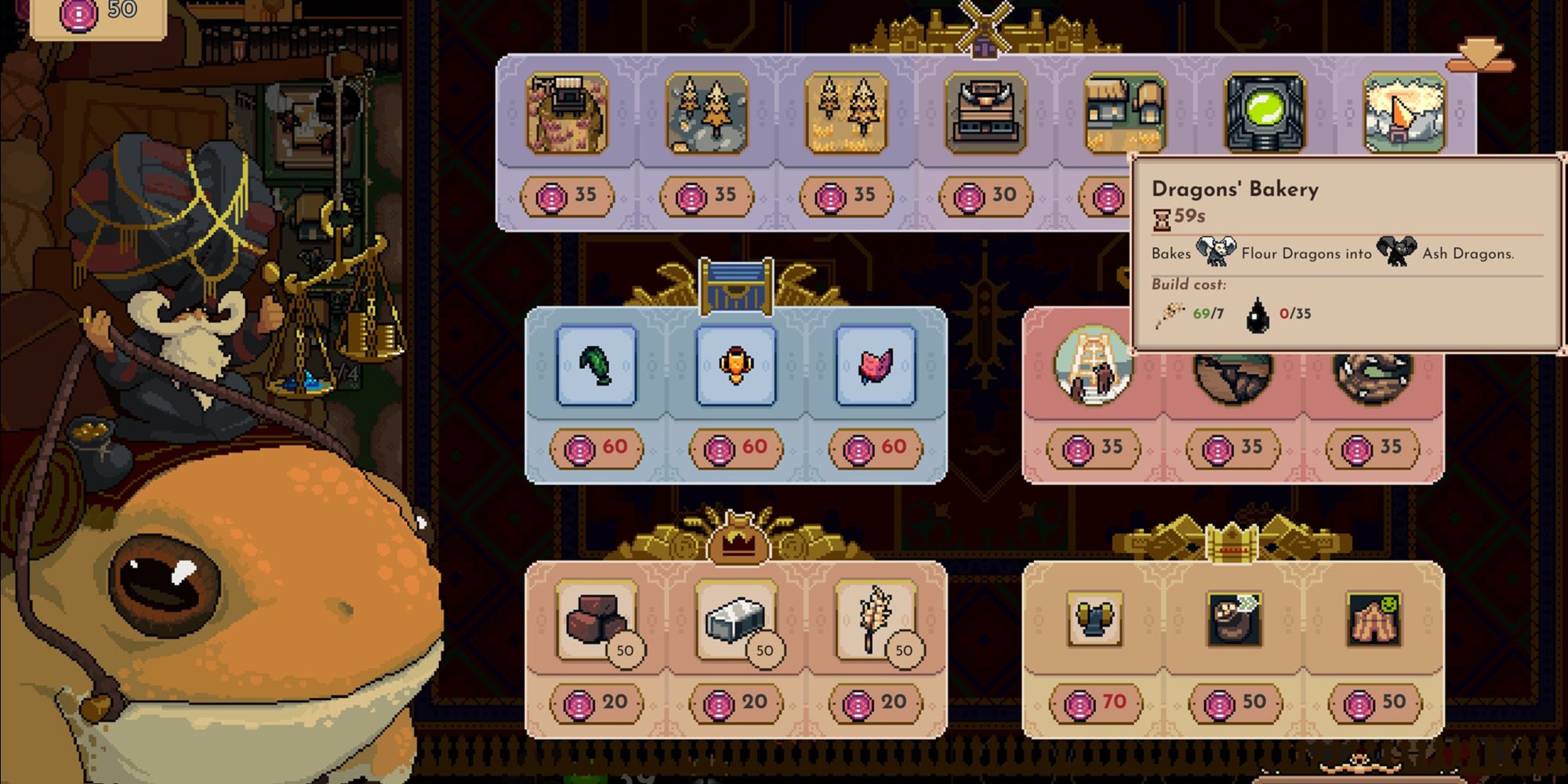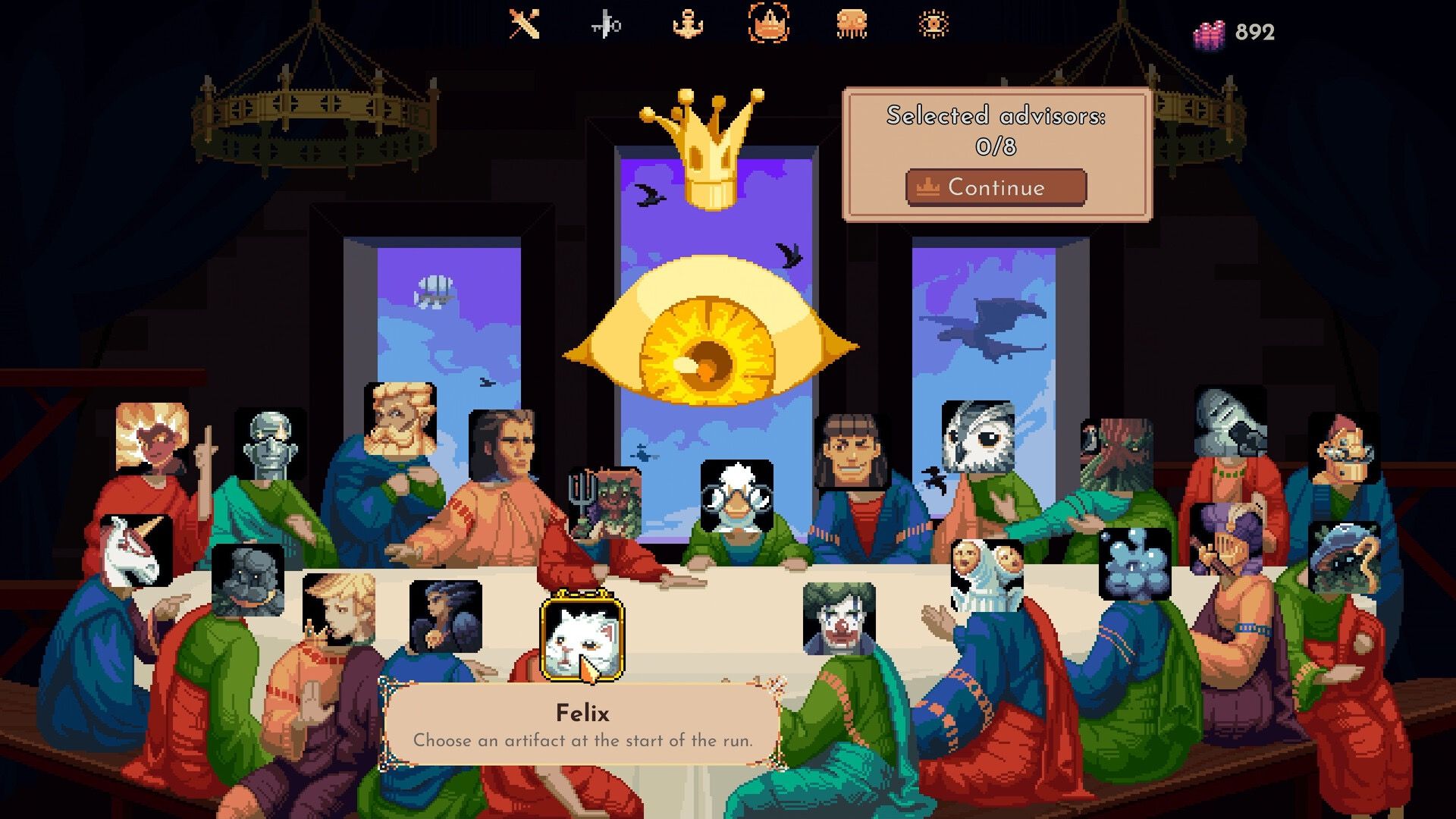Imagine, if you will, you are a Goose Rider. You wake up each morning, being prepared to die for your omniscient overlord King, alongside your friends, the Ash Dragon and the madman.
Just as you’re about to fight The Ironfang Riders, a ruthless band of mercenaries, you hear the King’s voice in your ear – we’re going to let them attack the walls.
You stand down, knowing the King has a plan, and sure enough, The Ironfang Riders launch themselves at the castle walls, only to find that their puny swords can do nothing.
Something inside you knows the walls are stronger now – about 20 hit points if you have to put a number on it.
These are the sort of scenarios you’ll find yourself in throughout The King is Watching, a kingdom-builder/deckbuilder/roguelite whereby you control the King and survive against your enemies for as long as you can.
Manage Your Gaze And Your Time
The twist is, most people only work when the King is watching them, so you have to manage your gaze to go where it’s needed most. Just keep an eye on the clock in real life too if you need to catch a train, otherwise, you might miss a few of your errands.
When you first open up the game, you’re greeted with a few things: One, the game starts with a surreal point-and-click element, whereby you make flowers grow out of your advisors.
Two, most of the advisors on your council are a variety of animals. In fact, you yourself begin as a mouse king.
Three, there’s a tutorial, which I’d recommend playing first, to get an idea about all the game’s systems.
Micro And Macro Management
The game’s systems might seem overwhelming to begin with, with a constant mix of micro and macro managing to do for your kingdom, but you’ll soon develop a rhythm for it.
Just like a great game of chess, the game starts off basic, with the same few moves available to you – build some wells, unlock forests and fields, watch all three to gain three materials at the same time.
Then, unlock the Small Peasant Hut to allow for Peasants to be recruited for your army, just in time for the first waves of enemies to appear.
Prophetic Planning
From then on, the game becomes much more open, especially when you unlock your first prophecy. Prophecies allow you to tailor the next 3 waves of enemies to your tastes, with up to 3 layers of enemies being able to be placed in each wave.
Just like a great game of chess, the game starts off basic.
Outside the inevitable level of enemies (blue), which are the weakest but offer the smallest rewards, you also have intermediate (orange) and risky (red) ones, which offer more powerful enemies but much greater or more useful rewards.
This offers a fantastic risk and reward system as you try and predict how much punishment your kingdom can take.
Humour And More Choices
Back to the game’s opening and the flower growing. This shows off the game’s darkly whimsical humour, which pops up a lot in the choices you have between rounds, as well as in the boss enemies’ descriptions.
Every choice is spun in a way where the King comes out on top, even if he shouldn’t, and it made me feel oddly proud of how the kingdom operates.
For example, when a soldier sneezes on a trader, who then demands his nose as punishment, you can choose to make a replica of the soldier and give it to the trader, who sees no difference. The King is always one step ahead, and so, you feel, are you.
Oh, Hubris
Until you let your confidence get the better of you, that is. You might feel you have a large enough army, or enough food etc. and might decide to start clearing out space for more complicated buildings, or try and grind Furniture to allow for more Town Denarii between runs.
Quickly, the enemy has overpowered you, getting to your walls. Then, no matter how many units you send out to fight, the enemy will keep attacking the wall until it’s destroyed – or you are.
Hubris is a wonderful thing, as I suddenly fell in Week 20 after getting to the final boss in the last 3 consecutive runs because I took my eye off the ball. Literally.
No Feeling Of Resentment
However, I never felt cheated by the game, always being able to reason out the choices that caused my downfall. Of course, this being a deckbuilder, sometimes you might just not get the buildings you need for the units or resources you’re planning to use.
If this is the case, you have two options: one, keep rerolling and hoping you get the building you want. Or you could remove the buildings from the kingdom and refocus your efforts on what you do have.
“…I never felt cheated by the game.”
Resources for buildings were never so high that I felt I couldn’t pivot and refocus, weathering the storm until I could get my kingdom back on track.
And you might suddenly get a macro-level choice which gives you just what you need, so there’s never a feeling of early choices messing you up.
Town-Altering Choices
In between each run, you receive some Town Denarii based on how long you’ve survived, allowing you to first purchase the buildings that unlock Upgrades, the Encyclopedia, the Council, etc.
These initial purchases feel a little arbitrary, given they unlock areas of a game which are normally provided free of charge.
If they felt they didn’t want the game to feel overwhelming with choice, then you could have unlocked them by playing the tutorial or completing challenges for areas like the Gallery instead of having to use about 2 runs worth of Town Denarii to unlock them yourself.
Lack Of Save States And Key Bindings
There are only two other real negatives I have with the game, so we’ll get them out of the way here. Firstly, you can’t save mid-run. This feels like an oversight in these modern times when most games try to respect your time.
This is especially true as a run can easily last over an hour, and with a laptop not allowing for suspension states, you just have no choice but to leave the game on.
Thankfully, the devs seem to be quite good at listening to community feedback, with a ‘report a bug’ feature prominently displayed in the top left corner of the menu, and a mid-run save feature currently in beta testing. Still, it’s worth noting it’s not there when the game was meant to be feature complete.
The devs seem to be quite good at listening to community feedback.
The other issue to mention is there’s no current way to rebind keys. Actually, there’s no way to check what the keybindings are to begin with.
This was a particular problem when playing on the Steam Deck, as to move buildings, you have to press Shift, which isn’t a button on the Deck itself. You’d have to manually rebind from the Deck’s own systems, which is a bit of a faff.
Outside of these small oversights, which can be updated relatively simply, I have nothing but love for this game. I haven’t played a game in a while which I feel the want to wake up in the morning and just jump straight on rather than procrastinating.
I might have mentioned the addictive nature of the game once, or twice.
And with six further Kings to unlock, as well as multiple threat levels to complete which give you Ascencion Crystals to power up your Kingdom further, the game seems to really want you to dive in and not rest on your laurels.
Graphics And Music
The graphics are lovely, being reminiscent of Kingdom Rush, and the animations and creature designs are full of life.
I would have loved a little bit more representation of the choices to reflect in the world. For example, seeing the cultists hide in the forest, but that might hinder the performance of the game, which is perfect for playing on a laptop.
And trust me, you’ll want to take this game with you. I might have mentioned the addictive nature of the game once, or twice.
The music is really atmospheric and perfect for the game. Of course, being a game with repeated gameplay, you are also more than welcome to play with no sound, too. This is a game perfect for listening to something else in the background.
Overall, I had an absolute blast with The King is Watching. The main gameplay loop is extremely well thought-out and incredibly engaging, and I can’t wait to continue playing the game and seeing what all the Kings and advisors bring to the table. Speaking of, I feel my gaze needs to fall on to Steam again now. The King needs to watch his subjects, after all.
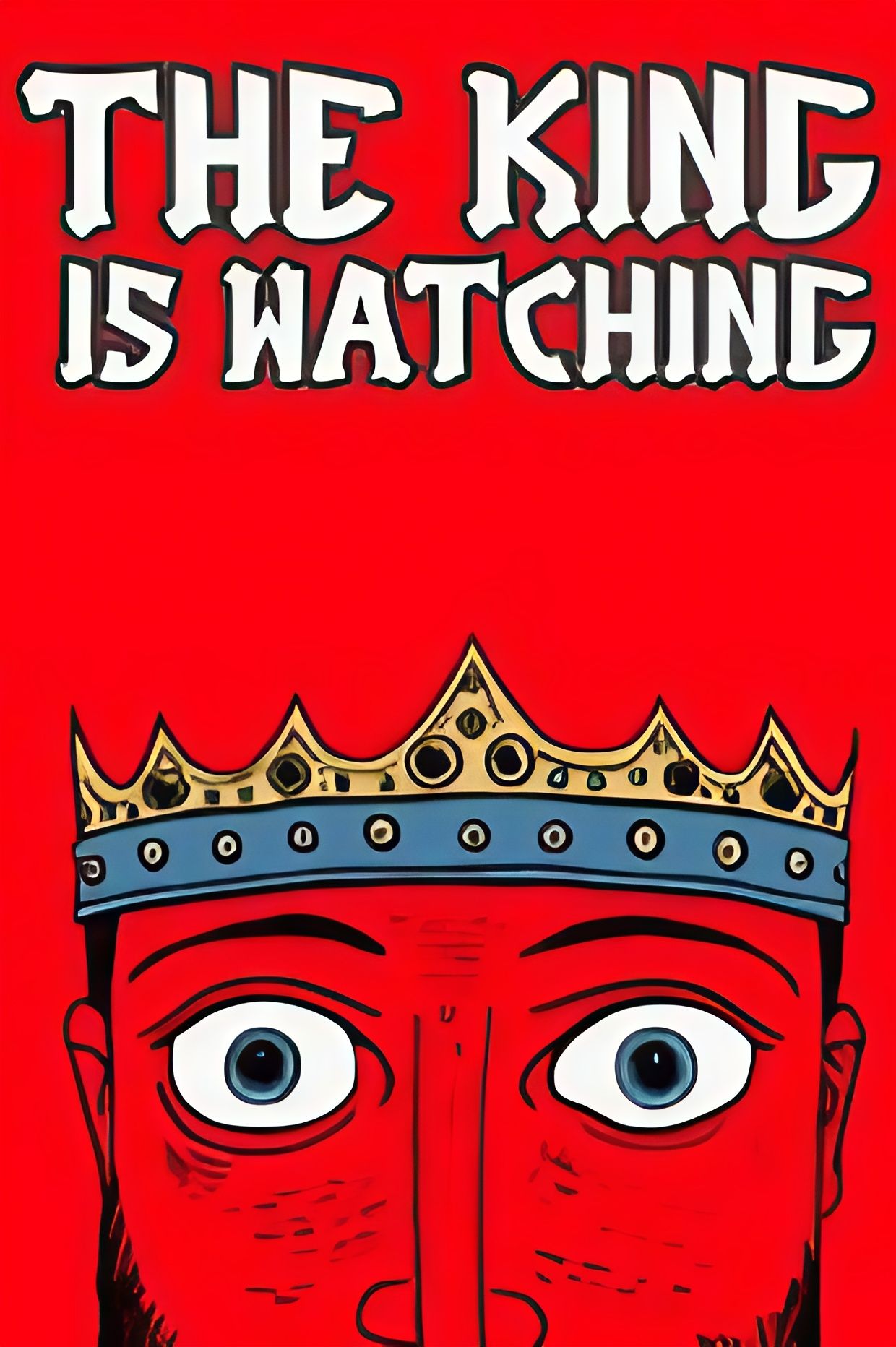
- Extremely addictive ‘just-one-more-run’ gameplay
- Strong art style
- Some really ‘out-there’ upgrades and units like a Flour Dragon
- Whimsically dark writing
- Lots of upgrades and difficulty levels as rewards
- Great, atmospheric music
- Easy-to-learn, hard-to-master
- A great mix of micro and macro-managing
- Optimised enough to be able to be played on a Surface or other type of laptop for more time spent on the game on the go
- No mid-run save feature (this is on the roadmap)
- Some of the permanent upgrades feel like forced barriers to completing the game straight away
- Can’t rebind controls



